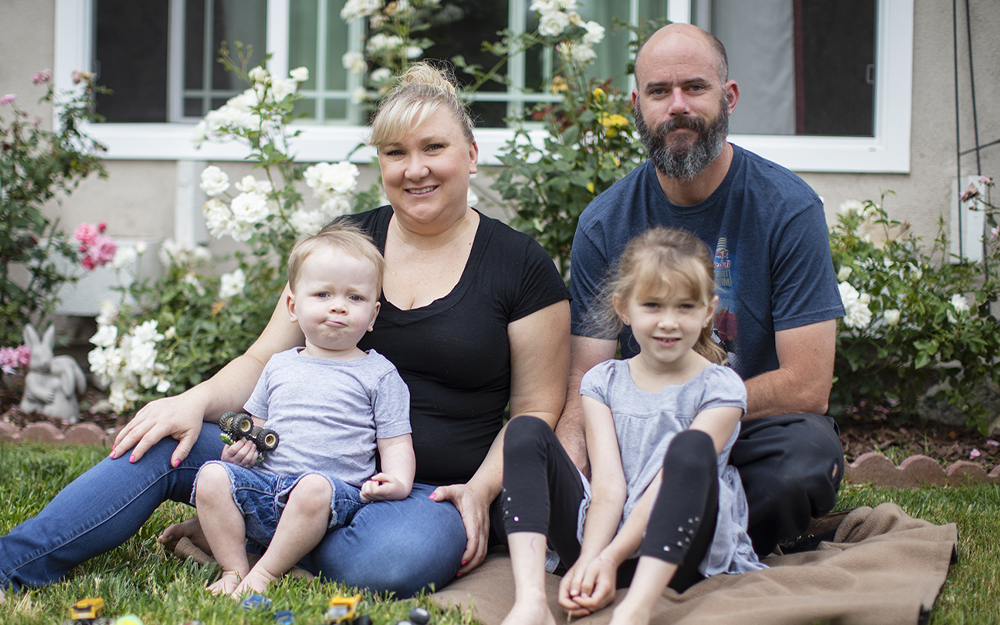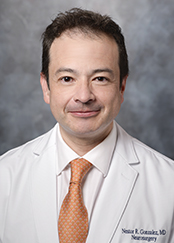Cedars-Sinai Blog
The Luckiest Unlucky Kid
Oct 06, 2017 Cedars-Sinai Staff

The Martin family.
Tanner Martin is the luckiest unlucky kid. He was born with a very rare and usually fatal brain condition. With three surgeries before his 3rd birthday, he's overcome the odds.
Tanner Martin was born with a serious vascular condition in his brain that only happens once in every 3 million births. It can seriously damage the brain and the heart, and it's almost always fatal.
He hasn't had his 3rd birthday yet, but he's had 3 major surgeries—2 brain surgeries and an eye surgery. He's logged more days in intensive care units than his mom, Kelli, can easily count. As she says, "He's already been through so much in his little life."
Yet, he's also been lucky. Lucky to be born to a tenacious mom with an eye for picking up any change in his behavior or any tiny physical symptom, and a knack for administering complicated medications.
Lucky his mom found the right team to help him. Lucky he survived a lifesaving surgery when the chances of him surviving were daunting. Lucky to be crawling, scooting and climbing over the incredible odds.
"It's a very delicate and difficult surgery. The risk is very high, and really against the odds compared to other brain surgeries that we do."
A longshot
Tanner has a vein of Galen malformation. Usually, arteries carry blood from the heart to capillaries in the brain—tiny, branch-like blood vessels that slow blood flow. In Tanner's case, the arteries connected directly to veins, resulting in an aneurysm. The fast rush of blood forces the heart to work overtime. From birth, Tanner's heart raced hard, like he was constantly sprinting through a marathon.
The condition can seriously damage the brain, heart, lungs and kidneys.
He was diagnosed a little more than a month before he was born, and Kelli started looking for the right specialist to help her son. She found Nestor Gonzalez, MD, who works with medical centers throughout Southern California to treat kids and babies with vascular malformations in their brains. Tanner met Gonzalez, who worked at a different hospital at the time, when he was just 3 days old.
Tanner was too little and fragile to have surgery immediately, so Gonzalez advised they wait for him to get a little bigger and stronger. In the meantime, Tanner took heart medications to control his blood pressure and other complicated issues stemming from the aneurysm.
But after 3 months, the medications weren't enough to support his heart, and surgery became the only hope for saving his life.
Gonzalez worked with a team of cardiologists for 9 hours. They placed tiny platinum spring-shaped coils in the affected blood vessels in the brain to block the heavy blood flow. He wanted to place at least 8 coils—he was able to place 35. With each one, Tanner's heart responded, and his blood pressure dropped closer to what's normal for an infant.
"It's a very delicate and difficult surgery," says Gonzalez, now director of the Neurovascular Laboratory at Cedars-Sinai. "The risk is very high, and really against the odds compared to other brain surgeries that we do."
Nestor R. Gonzalez, MD
Over the next months, Tanner recovered. Kelli slept next to him, waking up hourly to give him the medications he needed to protect his heart and organs. With the approval of Tanner's doctors, she adjusted his dosages as needed based on his behavior and symptoms.
Around his first birthday the following December, Tanner's health took a downward turn. The veins in his head started to bulge and look very blue, and a bluish bubble appeared on the side of his nose near his eye. His head started to tilt strangely. Kelli recalls getting the results on his MRI on Christmas Eve. Instead of wrapping presents, she brought her son to Gonzalez at Cedars-Sinai for his second surgery. More coils and a special kind of glue were used to further slow the blood flow around his aneurysm. His surgery went well.
"From that point to now,” Kelli says, "it's like a miracle."
Doing things his own way
In the last year, Tanner has learned to sit, crawl, scoot and climb. In the last few months, he's started walking. He coos and babbles, mimicking familiar tones and sounds. His growth and development are on par with a 15-month-old. They work on his skills every day to try to catch him up. He's making great progress, Gonzalez says, with no significant lasting brain or heart damage. He'll start preschool this fall.
In each stage, he's found a unique way of doing things. His crawling style looks something like a breast stroke, for instance.
"Anything Tanner has ever done, all the therapists say they've never seen a child do something that way before," Kelli says. "And that's how it works for Tanner."
Not surprising, in some ways. From the day he was born, he's found his own way through life. Luckily, he's had his mom and medical science to help him.
In Discoveries: Better Brain Surgery
Learn more about the Pediatric Neurosurgery Program and Expert Team at Cedars-Sinai





